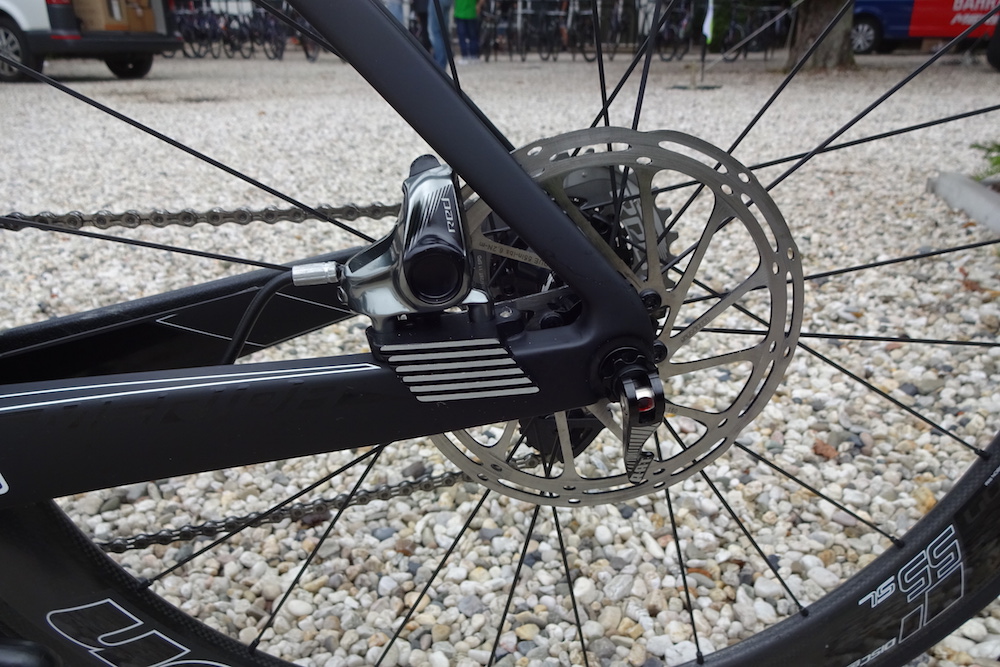New Merida Reacto is lighter, more aero and more comfortable
Merida says that the third generation of the Reacto, launched last week, skims the 6.8kg UCI weight limit and is 4% more aero than its predecessor


The Merida Reacto was originally launched in 2011. There’s a bit of an arms race in aero design, with the German Tour magazine rating 2013’s second generation machine the second fastest aero machine in the peloton in 2014. By the time it repeated its tests in 2016, the Reacto was still in the top ten, but newer aero bikes from other manufacturers were supplanting it at the top of the table.
So the third generation Reacto has been designed to put Merida right back up there with the best. Merida’s main aims for the new design were fourfold: improved aerodynamics, decreased weight, increased comfort, equivalent stiffness.

In addition Merida wanted rim and disc versions, good cockpit integration and simple maintenance. It says that the new bike, offered in a higher performance CF4 and a lower priced CF2 model, has achieved all these objectives.
The CF4 has a pro race geometry and Merida says that its contact point geometry is the same as on the Scultura climber’s bike, so it’s easy for its sponsored Bahrain-Merida team to switch between them. The CF2 has a slightly longer head tube, a flippable seatpost head and separate bar and stem rather than the CF4’s aerobar.
Aero enhancements
Merida used CFD to model the new Reacto’s aero performance, then followed this up with wind tunnel tests. It says that there’s a 4% increase in aero efficiency relative to the older Reacto model, saving 8 Watts.
Amongst aero enhancements are narrower frame cross-sections, a slimmer seatpost and an extension of the bottom bracket shell to shield the direct mount rear brake.

Merida has also increased the bike’s level of integration and has worked with FSA to develop a new Vision Metron 6D bar. With a straighter, slightly narrower profile than the Metron 5D, the new bar will be exclusive to Merida for a year before Vision sells it aftermarket.
The latest race content, interviews, features, reviews and expert buying guides, direct to your inbox!
It has tested the new Reacto under Vincenzo Nibali in a wind tunnel and found that at 45kph, there was around an 18 Watt power saving relative to a Scultura climbing bike.
Weight and comfort improvements
Merida says that it has shaved around 18% from the overall weight of the bike, with its new frame and fork design augmented by changes in the seatpost, clamp and headset. Frame weight for the CF4 is down to just over 1000g from 1250g, with the new fork weighing 368g, down from 406g. It says that the weight penalty for a pro build relative to its Scultura climber’s bike is only around 100g, skimming the UCI’s 6.8kg weight limit.

The Reacto’s comfort has been increased with the slimmed down seatpost too. It contains an aero elastomer insert that is larger than on the older model, which Merida says adds 24% to its compliance. There’s clearance for 25mm tyres.
Merida says that the old Reacto provided good stiffness and power transfer, so there was no need to augment this.
Riding the new Reacto for over 100 miles over three days at the launch event, the ride comfort stood out. It’s not a bike that jolts you around, even over the less manicured roads around the Hoge Veluwe national park south of Apeldoorn in the Netherlands.
We did find that we could induce brake rub with out-of-saddle efforts though, a result of the forces acting on the chainstays and wheel rims.
Disc brake options
As well as rim brakes, Merida will sell a disc brake version of the new Reacto alongside its Scultura Disc. It says that discs don’t reduce the bike’s aerodynamics significantly, although the frame weight increases by around 150g to cope with the different braking forces.

The design includes Merida’s disc cooler heat sinks, that it says increase heat loss by around 50% and lead to a 70C decrease in rotor temperature. Merida also uses the RAT quick release thru-axle system which it has licensed from Focus.
At launch, the Reacto will be available in three CF4 versions and three CF2 versions, five of them with disc brake options.
Paul started writing for Cycling Weekly in 2015, covering cycling tech, new bikes and product testing. Since then, he’s reviewed hundreds of bikes and thousands of other pieces of cycling equipment for the magazine and the Cycling Weekly website.
He’s been cycling for a lot longer than that though and his travels by bike have taken him all around Europe and to California. He’s been riding gravel since before gravel bikes existed too, riding a cyclocross bike through the Chilterns and along the South Downs.
